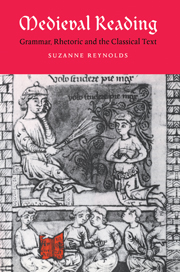Book contents
- Frontmatter
- Contents
- Acknowledgments
- Abbreviations
- 1 Introduction
- Part I CONTEXTS FOR READING
- Part II READING PRACTICE
- 4 Origins and mythologies: the invention of language and meaning
- 5 Reading word by word 1: the role of the vernacular
- 6 Reading word by word 2: grammatical and rhetorical approaches
- 7 From words to the phrase: the problem of syntax
- 8 Government: the theory and practice of a grammatical concept
- 9 Rival orders of syntax: vernacular, natural and artificial
- 10 From the phrase to the text: grammatical and rhetorical approaches again
- 11 Naked intention: satire and a new kind of literal reading
- 12 Literacy: a new model for the classical text in the Middle Ages?
- Notes
- Select bibliography
- General index
- Index of manuscripts
- Cambridge Studies in Medieval Literature
8 - Government: the theory and practice of a grammatical concept
from Part II - READING PRACTICE
Published online by Cambridge University Press: 22 September 2009
- Frontmatter
- Contents
- Acknowledgments
- Abbreviations
- 1 Introduction
- Part I CONTEXTS FOR READING
- Part II READING PRACTICE
- 4 Origins and mythologies: the invention of language and meaning
- 5 Reading word by word 1: the role of the vernacular
- 6 Reading word by word 2: grammatical and rhetorical approaches
- 7 From words to the phrase: the problem of syntax
- 8 Government: the theory and practice of a grammatical concept
- 9 Rival orders of syntax: vernacular, natural and artificial
- 10 From the phrase to the text: grammatical and rhetorical approaches again
- 11 Naked intention: satire and a new kind of literal reading
- 12 Literacy: a new model for the classical text in the Middle Ages?
- Notes
- Select bibliography
- General index
- Index of manuscripts
- Cambridge Studies in Medieval Literature
Summary
MS Vatican City, Biblioteca Apostolica Vaticana, Reg. lat. 3259 (v) seems to have been designed with authority (auctoritas) in mind. It is a handsome northern French mid twelfth-century manuscript of the complete works of Horace and the Satires of Persius, which in the sixteenth century formed part of the impressive personal library of the Roman antiquarian Fulvio Orsini. It is a much higher-grade product than the other manuscripts I discuss in this book; the main text is written in a good book hand (hand i) which also writes marginal glosses which are ruled for – they are part of the book's original intention. There are two further layers of marginal glossing, not ruled for, and squeezed in and around the original marginal commentary. The second is in an Italian hand of the fourteenth century, and falls outside the scope of this study, but the first is in a later twelfth-century glossing hand (hand 2) and consists of a series of very heavily abbreviated glosses, including extracts from the text which are underlined. These features suggest that hand 2 copied the glosses from continuous or catena commentary on Horace in order to adapt v for pedagogic use. This suggestion is strengthened by the many linking syntactic glosses in hand 2, glosses whose abundance and consistency represent a sustained analysis which used the authoritative text as the basis for an examination of Latin syntax.
- Type
- Chapter
- Information
- Medieval ReadingGrammar, Rhetoric and the Classical Text, pp. 97 - 109Publisher: Cambridge University PressPrint publication year: 1996



